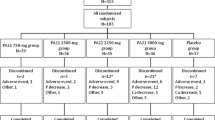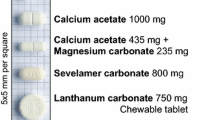Abstract
Background: Hyperphosphatemia is common in hemodialysis patients. Recent animal studies show that nicotinamide inhibits the sodium dependent phosphate co-transport in the small intestine and thereby reduces serum phosphorus levels. Nicotinic acid which is the prodrug of nicotinamide is widely used as antihyperlipidemic agent. We examined in a prospective study whether it reduces serum phosphorus levels in hemodialysis patients. Methods: Patients who were on maintenance hemodialysis were enrolled in to the study if their predialysis serum phosphorus was more than 6 mg/dl. During the pre-trial run in period of 1 week all phosphate binders were stopped. A single dose of extended release nicotinic acid (375 mg) tablet was given with meal. Repeat measurements of serum calcium, phosphorus and alkaline phosphatase were carried out after 8 weeks. Then the drug was stopped in a subgroup of patients and serum phosphorus remeasured after 2 weeks. Results : There were 34 patients with varied etiological spectrum of end stage renal disease. They were on hemodialysis for a mean period of 8.7 months. Serum phosphorus levels changed significantly from a pre treatment level of 7.7±1.5 mg/dl to post treatment level of 5.6 ±1 mg/dl (p<0.001). There was no significant variance across age groups, sex, disease categories and dialysis duration. The calcium level increased from 8.1±1.0 to 8.5±1.0 mg/dl (p<0.015). The serum alkaline phosphatase level decreased significantly from 107±66 IU/l to 82±46 IU/l (p<0.001 ). There was a significant reduction of calcium phosphate product from 63.1+15.1 mg2 to 48.7±10.9 mg2/dl2 (p<0.001). Oral nicotinic acid was well tolerated. Mild pruritus was encountered in 2 patients. Conclusion: Oral nicotinic acid may emerge as a safe, low cost yet powerful agent for phosphorus control in dialysis patients.
Similar content being viewed by others
References
E Slatopolsky AM Robson JF Rosen (1968) ArticleTitleControl of phosphate excretion in uremic man J Clin Invest 47 1865–1874 Occurrence Handle1:CAS:528:DyaF1cXkslGisLY%3D Occurrence Handle5666116
Martin KJ, Gonzalez EA, Slatopolsky E. Brenner and Rector’s The Kidney, Vol. 2, 7th edn. Saunders, 2004; 2255–2293.
Lorenzo V, Martin-Malo A, Perez-Garcia R et al. Prevalence, clinical correlates and therapy cost of mineral abnormalities among haemodialysis patients: a cross-sectional multicentre study. Nephrol Dial Transplant. 2005 Nov 1; [Epub ahead of print].
RM Lindsay F Alhejaili G Nesrallah et al. (2003) ArticleTitleCalcium and phosphate balance with quotidian hemodialysis Am J Kidney Dis 42 IssueID1 Suppl 24–29 Occurrence Handle12830440
AC Alfrey GR Legendre WD Kaehny (1976) ArticleTitleThe dialyis encephalopathy syndrome. Possible aluminium intoxication N Engl J Med 294 184–188 Occurrence Handle1:STN:280:CSmD2srlvFQ%3D Occurrence Handle1244532
E Slatopolsky C Weerts S Lopez-Hilker et al. (1986) ArticleTitleCalcium carbonate as a phosphate binder in patients with chronic renal failure undergoing dialysis N Eng J Med 315 157–161 Occurrence Handle1:STN:280:BimB2MjjtVE%3D
GA Block TE Hulbert-Shearon NW Levin et al. (1998) ArticleTitleAssociation of serum phosphorus and calcium×phosphate product with mortality risk in hemodialysis patients Am J Kidney Dis 31 601–617
F Meric P Yap MJ Bia (1990) ArticleTitleEtiology of hypercalcemia in hemodialysis patients on calcium carbonate therapy Am J Kid Dis 5 459–464
Y Slinin RN Foley AJ Collins (2005) ArticleTitleCalcium, phosphorus, parathyroid hormone, and cardiovascular disease in hemodialysis patients: the USRDS waves 1, 3, and 4 study J Am Soc Nephrol 16 IssueID6 1788–1793 Occurrence Handle10.1681/ASN.2004040275 Occurrence Handle1:CAS:528:DC%2BD2MXls1ehsr0%3D Occurrence Handle15814832
GM Chertow SK Burke JM Lazarus et al. (1997) ArticleTitlePoly (allylamine hydrochloride)RenaGel: A noncalcemic phosphate binder for the treatment of hyperphosphatemia in chronic renal failure Am J Kidney Dis 29 66–71 Occurrence Handle1:CAS:528:DyaK2sXnsVaksQ%3D%3D Occurrence Handle9002531
E Slatopolsky H Liapis J Finch (2005) ArticleTitleProgressive accumulation of lanthanum in the liver of normal and uremic rats Kidney Int 68 IssueID6 2809–2813 Occurrence Handle10.1111/j.1523-1755.2005.00753.x Occurrence Handle1:CAS:528:DC%2BD28XhslWjtA%3D%3D Occurrence Handle16316357
H Debiec R Lorenc (1988) ArticleTitleIdentification of Na, Pi binding protein in kidney and intestinal BB membranes Biochem J 255 IssueID1 185–191 Occurrence Handle1:CAS:528:DyaL1cXmtVOjsrk%3D Occurrence Handle3196312
NA Breslau (1996) Calcium,magnesium and phosphorus :Intestinal absorption MJ Favus (Eds) Primer on Metabolic Bone Diseases and Disorders of Mineral Metabolism Lippincott Raven Philadelphia 57–63
C Amiel et al. (1996) Hypo-hyperphosphatemia A Davison S Cameron JP Grunfeld C Ponticelli E Ritz C Winearls (Eds) Oxford TextBook of Clinical Nephrology Oxford University Press Oxford 249–269
N Eto Y Miyata H Ohno T Yamashita (2005) ArticleTitleNicotinamide prevents the development of hyperphophatemia by suppressing intestinal sodium dependent phosphate transporter in rats with adenine induced renal failure Nephrol Dial Transplant 20 1378–1384 Occurrence Handle1:CAS:528:DC%2BD2MXpt1Cjs7w%3D Occurrence Handle15870221
Y Takahashi A Tanaka T Nakamura et al. (2004) ArticleTitleNicotinamide suppresses hyperphosphatemia in hemodialysis patients Kidney Int 65 1099–1104 Occurrence Handle10.1111/j.1523-1755.2004.00482.x Occurrence Handle1:CAS:528:DC%2BD2cXitleksbY%3D Occurrence Handle14871431
K Shimoda T Akiba T Matsushima et al. (1998) ArticleTitleNiceritrol reduces serum phosphate in chronic hemodialysis patients Nippon Jinzo Gakkai Shi 40 IssueID1 1–7 Occurrence Handle1:STN:280:DyaK1c7nsVGlsA%3D%3D Occurrence Handle9513376
N Kuboyama Y Watanabe M Yamaguchi et al. (1999) ArticleTitleEffects of niceritrol on fecal and urinary phosphate excretion in normal rats Nephrol Dial Transplant 14 IssueID3 610–614 Occurrence Handle1:CAS:528:DyaK1MXitFalsbs%3D Occurrence Handle10193807
K Katai H Tanaka S Tatsumi et al. (1999) ArticleTitleNicotinamide inhibits sodium dependent phosphate cotransport activity in rat small intestine Nephrol Dial Transplant 14 IssueID5 1195–1201 Occurrence Handle1:CAS:528:DyaK1MXjsFaqsrs%3D Occurrence Handle10344361
Author information
Authors and Affiliations
Corresponding author
Rights and permissions
About this article
Cite this article
Sampathkumar, K., Selvam, M., Sooraj, Y.S. et al. Extended Release Nicotinic Acid – A Novel Oral Agent for Phosphate Control. Int Urol Nephrol 38, 171–174 (2006). https://doi.org/10.1007/s11255-006-0001-x
Issue Date:
DOI: https://doi.org/10.1007/s11255-006-0001-x




